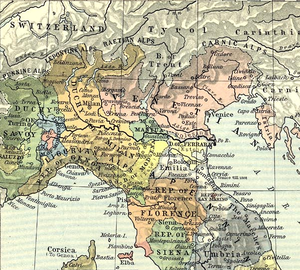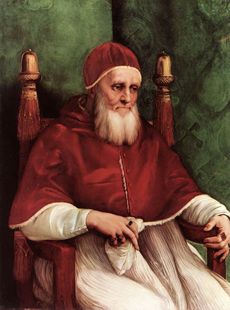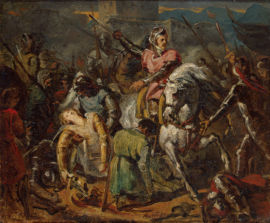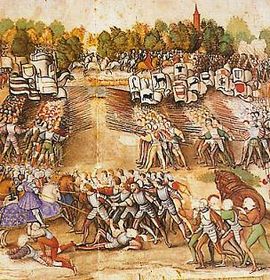War of the League of Cambrai
2007 Schools Wikipedia Selection. Related subjects: Pre 1900 Military
| War of the League of Cambrai | |||||||
|---|---|---|---|---|---|---|---|
| Part of the Italian Wars | |||||||
 Northern Italy in 1494; by the start of the war in 1508, Louis XII had expelled the Sforza from the Duchy of Milan and added its territory to France. |
|||||||
|
|||||||
| War of the League of Cambrai |
|---|
| Agnadello – Padua – Brescia – Ravenna – St. Mathieu – Novara – Guinegate – Flodden Field – La Motta – Marignano |
| Italian Wars |
|---|
| First – Second – League of Cambrai – Urbino – 1521 – League of Cognac – 1535 – 1542 – 1551 |
The War of the League of Cambrai, sometimes known as the War of the Holy League and by several other names, was a major conflict in the Italian Wars. The principal participants of the war, which was fought from 1508 to 1516, were France, the Papal States, and the Republic of Venice; they were joined, at various times, by nearly every significant power in Western Europe, including Spain, the Holy Roman Empire, the Kingdom of England, the Kingdom of Scotland, the Duchy of Milan, Florence, the Duchy of Ferrara, and the Swiss.
Pope Julius II had intended that the war would curb Venetian influence in northern Italy, and had, to this end, created the League of Cambrai (named after Cambrai, where the negotiations took place), an alliance against the Republic that included, besides himself, Louis XII of France, Emperor Maximilian I, and Ferdinand I of Spain. Although the League was initially successful, friction between Julius and Louis caused it to collapse by 1510; Julius then allied himself with Venice against France.
The Veneto-Papal alliance eventually expanded into the Holy League, which drove the French from Italy in 1512; disagreements about the division of the spoils, however, led Venice to abandon the alliance in favour of one with France. Under the leadership of Francis I, who had succeeded Louis to the throne, the French and Venetians would, through their victory at Marignano in 1515, regain the territory they had lost; the treaties of Noyon and Brussels, which ended the war the next year, would essentially return the map of Italy to the status quo of 1508.
Prelude
In the aftermath of the First Italian War, Pope Alexander VI had moved to consolidate Papal control over central Italy by seizing the Romagna. Cesare Borgia, acting as gonfaloniere of the Papal armies, had expelled the Bentivoglio family from Bologna, which they had ruled as a fief, and was well on his way towards establishing a permanent Borgia state in the region when Alexander died on 18 August 1503. Although Cesare managed to seize the remnants of the Papal treasury for his own use, he was unable to secure Rome itself, as French and Spanish armies converged on the city in an attempt to influence the Papal conclave; the election of Pius III (who soon died, to be replaced by Julius II) stripped Cesare of his titles and relegated him to commanding a company of men-at-arms. Sensing Cesare's weakness, the dispossessed lords of the Romagna offered to submit to the Republic of Venice in exchange for aid in regaining their dominions; the Senate accepted and had taken possession of Rimini, Faenza, and a number of other cities by the end of 1503.
Julius II, having secured his own control of the Papal armies by arresting and imprisoning Cesare, first in Rome and later in Madrid, quickly moved to re-establish Papal control over the Romagna by demanding that Venice return the cities she had seized; the Republic, although willing to acknowledge Papal sovereignty over them and pay Julius an annual tribute, refused to surrender the cities themselves. In response, Julius concluded an alliance with France and the Holy Roman Empire against Venice; the death of Isabella of Castile and the resulting collapse of relations between the parties soon dissolved the alliance, but not before Venice had been induced to abandon several of the cities. Julius, although unsatisfied with his gains, did not himself possess sufficient forces to fight the Republic; for the next two years he instead occupied himself with the reconquest of Bologna and Perugia, which, located between Papal and Venetian territory, had in the meantime assumed a state of quasi-independence.
In 1507, Julius returned to the question of the cities in Venetian hands; once again rebuffed by the Senate, he encouraged the recently elected Emperor Maximilian I to attack the Republic. Maximilian, using his journey to Rome for the Imperial coronation as a pretext, entered Venetian territory with a large army in February 1508 and advanced on Vicenza, but was defeated by a Venetian army under Bartolomeo d'Alviano. A second assault by a Tyrolean force several weeks later was an even greater failure; Alviano not only routed the Imperial army but also proceeded to seize Trieste and Fiume, forcing Maximilian to conclude a truce with Venice.
League of Cambrai (1508–10)
| Combatants in the War of the League of Cambrai | |
|---|---|
| League of Cambrai (1508–10) | |
| Papal States, France, Holy Roman Empire, Spain, Duchy of Ferrara |
Republic of Venice |
| Veneto-Papal alliance (1510–11) | |
| Papal States, Republic of Venice |
France, Duchy of Ferrara |
| Holy League against France (1511–13) | |
| Papal States, Republic of Venice, Spain, Holy Roman Empire, England, Swiss |
France, Duchy of Ferrara |
| Franco-Venetian alliance (1513–16) | |
| Papal States, Spain, Holy Roman Empire, England, Duchy of Milan, Swiss |
Republic of Venice, France, Scotland, Duchy of Ferrara |
Julius, humiliated by the failure of the Imperial invasion, turned to Louis XII of France (who, having been left in possession of Milan after the Second Italian War, was interested in further expansion into Italy) with an offer of alliance. In mid-March, the Republic provided a pretext for an attack on itself by appointing her own candidate to the vacant bishopric of Vicenza (an act in keeping with prevailing custom, though Julius considered it a personal provocation); the Pope proceeded to call for all Christian nations to join him in an expedition to subdue Venice. On 10 December 1508, representatives of the Papacy, France, the Holy Roman Empire, and Ferdinand I of Spain concluded the League of Cambrai against the Republic. The agreement provided for the complete dismemberment of Venice's territory in Italy and for its partition among the signatories: Maximilian, in addition to regaining Istria, would receive Verona, Vicenza, Padua, and the Friuli; France would annex Brescia, Crema, Bergamo, and Cremona to its Milanese possessions; Ferdinand would seize Otranto; and the remainder, including Rimini and Ravenna, would be added to the Papal States.
On 15 April 1509, Louis left Milan at the head of a French army and moved rapidly into Venetian territory. To oppose him, Venice had hired a condottiere army under the command of the Orsini cousins—Bartolomeo d'Alviano and Nicolo di Pitigliano—but had failed to account for the fact that the two disagreed on how best to stop the French advance. Consequently, when Louis crossed the Adda River in early May and Alviano advanced to meet him, Pitigliano, believing it best to avoid a pitched battle, moved away to the south. On 14 May, Alviano confronted the French at the Battle of Agnadello; outnumbered, he sent requests for reinforcements to his cousin, who replied with orders to break off the battle and continued on his way. Alviano, disregarding the new orders, continued the engagement; his army was eventually surrounded and destroyed. Pitigliano managed to avoid encountering Louis; but his mercenary troops, hearing of Alviano's defeat, had deserted in large numbers by the next morning, forcing him to retreat to Treviso with the remnants of the Venetian army.
The Venetian collapse was complete; Louis proceeded to occupy Venetian territory as far east as Brescia without encountering any significant resistance. The major cities that had not been occupied by the French—Padua, Verona, and Vicenza—were left undefended by Pitigliano's withdrawal, and quickly surrendered to Maximilian when Imperial emissaries arrived in the Veneto. Julius, having in the meantime issued an interdict against Venice that excommunicated every citizen of the Republic, invaded the Romagna and seized Ravenna with the assistance of the Duke of Ferrara, who had joined the League and seized the Polesine for himself.
The newly arrived Imperial governors, however, quickly proved to be unpopular. In mid-July, the citizens of Padua, aided by detachments of Venetian cavalry under the command of the proveditor Andrea Gritti, revolted; the landsknechts garrisoning the city were too few in number to mount effective resistance and Padua was restored to Venetian control on 17 July. The success of the revolt finally pushed Maximilian into action. In early August, a massive Imperial army, accompanied by bodies of French and Spanish troops, set out from Trento into the Veneto. Because of a lack of horses, as well as general disorganization, Maximilian's forces would not reach Padua until September, giving Pitigliano the time to concentrate such troops as were still available to him in the city. The Siege of Padua began on 15 September; although French and Imperial artillery successfully breached Padua's walls, the defenders managed to hold the city until Maximilian, growing impatient, lifted the siege on 30 September and withdrew to Tyrol with the main part of his army.

In mid-November, Pitigliano returned to the offensive; Venetian troops easily defeated the remaining Imperial forces, capturing Vicenza, Este, Feltre, and Belluno. Although a subsequent attack on Verona failed, Pitigliano managed to destroy a Papal army under Francesco II of Gonzaga in the process. A river attack on Ferrara by the Venetian galley fleet under Angelo Trevisan failed, however, when the Venetian ships, anchored in the Po River, were sunk by Ferrarese artillery; and a new French advance soon forced Pitigliano to withdraw to Padua once again.
Faced with a shortage of both funds and men, the Senate decided to send an embassy to Julius in order to negotiate a settlement. The terms insisted on by the Pope were harsh: the Republic lost her traditional power to appoint clergy in her territory, as well as all jurisdiction over Papal subjects in Venice, the Romagnan cities that had prompted the war were to be returned to Julius, and reparations were to be paid to cover his expenses in capturing them. The Senate argued over the terms for two months, but finally accepted them on February 24, 1510. Even before the Venetian ambassadors had presented themselves to Julius for absolution, however, the Council of Ten had privately resolved that the terms had been accepted under duress and were therefore invalid; and that Venice should violate them at the earliest opportunity.
This reconciliation between Venice and the Pope did not stop the French from again invading the Veneto in March. Pitigliano's death in January had left Andrea Gritti in command of the Venetian forces; although Maximilian failed to reinforce Louis, the French army was nonetheless sufficient to drive the Venetians from Vicenza by May. Gritti garrisoned Padua for an expected attack by a combined Franco-Imperial army; but Louis, more concerned by the death of his advisor, the Cardinal d'Amboise, abandoned his plans for a siege.
Veneto-Papal alliance (1510–11)
Julius, meanwhile, had become increasingly concerned by the growing French presence in Italy; more significantly, he had formulated plans to seize the Duchy of Ferrara, a French ally, and to add its territory to the Papal States. His own forces being inadequate for the venture, the Pope hired an army of Swiss mercenaries, ordering them to attack the French in Milan; he also invited Venice to ally with him against Louis. The Republic, facing a renewed French onslaught, readily accepted the offer.
By July 1510, the new Veneto-Papal alliance was on the offensive. An initial attack on French-occupied Genoa failed, but Venetian troops under Lucio Malvezzo finally drove the French from Vicenza in early August; and a joint force commanded by Francesco Maria della Rovere, the Duke of Urbino, captured Modena on 17 August. Julius now excommunicated Alfonso d'Este, thus justifying an attack on the Duchy itself; in anticipation of his coming victory, the Pope traveled to Bologna, so as to be nearby when Ferrara was taken.
The French army, however, had been left unopposed by the Swiss (who, having arrived in Lombardy, had been bribed into leaving by Louis) and was free to march south into the heart of Italy. In early October, Charles d'Amboise advanced on Bologna, splitting the Papal forces; by 18 October, he was only a few miles from the city. Julius now realized that the Bolognese were openly hostile to the Papacy and would not offer any resistance to the French; left with only a detachment of Venetian cavalry, he resorted to excommunicating d'Amboise, who had in the meantime been convinced by the English ambassador to avoid attacking the person of the Pope and had thus withdrawn to Ferrara.
In December, a newly assembled Papal army besieged the fortress of Mirandola; d'Amboise, marching to relieve it, fell ill and died, briefly leaving the French in disarray. Alfonso d'Este, meanwhile, confronted and destroyed the Venetian forces on the Po River, leaving Bologna isolated once more. Julius, afraid of being trapped by the French, departed the city for Ravenna. Cardinal Alidosi, whom he left behind to command the defense of the city, was no better liked by the Bolognese than Julius himself had been; and when, on 23 May 1511, a French army commanded by Gian Giacomo Trivulzio arrived at the gates, they quickly surrendered. Julius blamed this defeat on the Duke of Urbino, who, finding this quite unfair, proceeded to murder Alidosi in full view of the Papal guard.
Holy League (1511–13)
By June 1511, most of the Romagna was in French hands; the Papal army, disorganized and underpaid, was in no condition to prevent Trivulzio from advancing on Ravenna. In response to this debacle, Julius proclaimed a Holy League against France. The new alliance rapidly grew to include not only Spain and the Holy Roman Empire, who abandoned any pretense of adhering to the League of Cambrai in hopes of seizing Navarre and Lombardy from Louis, but also Henry VIII of England (who, having decided to use the occasion as an excuse to expand his holdings in northern France, concluded the Treaty of Westminster—a pledge of mutual aid against the French—with Ferdinand in November 1511).
In February 1512, Louis appointed his nephew, Gaston de Foix, to command the French forces in Italy. Foix proved more energetic than Amboise had been; having checked the advance of Ramón de Cardona's Spanish troops on Bologna, he returned to Lombardy to sack Brescia, which had rebelled against the French and garrisoned itself with Venetian troops. Aware that much of the French army would be diverted to deal with the impending English invasion, Foix and Alfonso d'Este besieged Ravenna, the last Papal stronghold in the Romagna, in hopes of forcing the Holy League into a decisive engagement. Cardona marched to relieve the city in early April, and was decisively beaten in the resulting Battle of Ravenna; the death of Foix during the fighting, however, left the French under the command of Jacques de la Palice, who, unwilling to continue the campaign without direct orders from Louis, contented himself with thoroughly sacking Ravenna.
By May 1512, the French position had deteriorated considerably. Julius had hired another army of Swiss mercenaries; they descended on Milan, bringing with them Maximilian Sforza, who was determined to regain control of the Duchy for his family. La Palice abandoned the Romagna (where the Duke of Urbino quickly captured Bologna and Parma) and retreated to Lombardy, attempting to intercept the invasion. By August, the Swiss had combined with the Venetian army and forced Triviulzio out of Milan, allowing Sforza to be proclaimed Duke with their support; La Palice was then forced to withdraw across the Alps.
In late August, the members of the League met at Mantua to discuss the situation in Italy (particularly the partition of territory acquired from the French). They quickly came to an agreement regarding Florence, which had angered Julius by allowing Louis to convene the Council of Pisa in its territory. At the Pope's request, Ramon de Cardona marched into Tuscany, smashed Florentine resistance, overthrew the Republic, and installed Cardinal Giuliano de' Medici as ruler of the city.
On the subject of territory, however, fundamental disagreements quickly arose. Julius and the Venetians insisted that Maximilian Sforza be permitted to keep the Duchy of Milan; Emperor Maximilian and Ferdinand conspired instead to have one of their cousins installed as duke. The Pope demanded the immediate annexation of Ferrara to the Papal States; Ferdinand objected to this arrangement, desiring the existence of an independent Ferrara to counter growing Papal power. Most problematic, however, was the attitude of Maximilian towards Venice. The Emperor refused to surrender any Imperial territory, which in his eyes included most of the Veneto, to the Republic; to this end, he signed an agreement with the Pope to exclude Venice entirely from the final partition. When the Republic objected, Julius threatened to reform the League of Cambrai against her. In response, Venice turned to Louis; on 23 March 1513, a treaty pledging to divide all of northern Italy between France and the Republic was signed at Blois.
Franco-Venetian alliance (1513–16)
In late May 1513, a French army commanded by Louis de la Trémoille crossed the Alps and advanced on Milan; at the same time, Bartolomeo d'Alviano and the Venetian army marched west from Padua. The unpopularity of Maximilian Sforza, who was seen by the Milanese as a puppet of his Swiss mercenaries, enabled the French to move through Lombardy with little resitance; Trémoille, having seized Milan, besieged the remaining Swiss in Novara. On 6 June, the French were attacked by a Swiss relief army at the Battle of Novara, and were routed despite having superior numbers. Detachments of the Swiss army pursued the fleeing French over the Alps and had reached Dijon before being bribed into withdrawing.
The rout at Novara inaugurated a period of continuous defeats for the French alliance. English troops under Henry VIII attacked La Palice at the Battle of Guinegate, scattered the French forces, and proceeded to sack Therouanne. In Navarre, resistance to Ferdinand's invasion collapsed; he rapidly consolidated his hold over the entire region and moved to support another English offensive in the Guyenne. James IV of Scotland invaded England at the behest of Louis; he failed to draw Henry's attention from France, and his disastrous defeat at the Battle of Flodden Field on 9 September 1513, ended Scotland's brief involvement in the war.
Meanwhile, Alviano, unexpectedly left without French support, retreated into the Veneto, pursued closely by the Spanish army under Cardona. While the Spanish were unable to capture Padua in the face of determined Venetian resistance, they penetrated deep into Venetian territory and by late September were in sight of Venice itself. Cardona attempted a bombardment of the city that proved largely ineffective; then, having no boats with which to cross the lagoon, turned back for Lombardy. Alviano, having been reinforced by hundreds of volunteers from the Venetian nobility, pursued Cardona and confronted him outside Vicenza on 7 October. In the resulting Battle of La Motta, the Venetian army was decisively defeated, with many prominent noblemen cut down outside the city walls as they attempted to flee.
However, the Holy League failed to follow up on these victories. Cardona and Alviano continued to skirmish in the Friuli for the rest of 1513 and through 1514, fighting several inconclusive battles, but Cardona was unable to make any real progress. Henry VIII, having failed to gain any significant territory, concluded a separate peace with France. Finally, the death of Julius left the League without a leader; Julius' successor to the Papacy, Leo X, was rather less concerned with military matters.
The death of Louis XII on 1 January 1515, brought Francis I to the throne. Having assumed the title of Duke of Milan at his coronation, Francis immediately moved to reclaim his holdings in Italy. By July, Francis had assembled an army in the Dauphiné. A combined Swiss and Papal force moved north from Milan to block the Alpine passes against him, but Francis, following the advice of Gian Giacomo Trivulzio, avoided the main passes and marched instead through the valley of the Stura. The French vanguard surprised the Milanese cavalry at Villafranca, capturing Prospero Colonna; meanwhile, Francis and the main body of the French confronted the Swiss at the Battle of Marignano on 13 September. The Swiss advance initially made headway; however, Francis' superiority in cavalry and artillery, together with the timely arrival of Alviano (who had successfully avoided Cardona's army at Verona) on the morning of 14 September, led to a strategically decisive victory for Francis and the Venetians.
Aftermath
After the defeat at Marignano, the League no longer possessed the ability or the will to continue the war. Francis advanced on Milan, capturing the city on 4 October and removing Sforza from the throne. In December, he met with Leo at Bologna; the pope, who had in the meantime been deserted by the remainder of his Swiss mercenaries, surrendered Parma and Piacenza to Francis and Modena to the Duke of Ferrara. In return, Leo received guarantees of French noninterference in his proposed attack on the Duchy of Urbino. Finally, the Treaty of Noyon, signed by Francis and Charles V in August 1516, recognized French claims to Milan and Spanish claims to Naples, removing Spain from the war.
Maximilian held out, making another attempt to invade Lombardy; his army failed to reach Milan before turning back, and by December 1516, he had entered into negotiations with Francis. The resulting Treaty of Brussels not only accepted French occupation of Milan, but also confirmed Venetian claims to the remainder of the Imperial possessions in Lombardy (except for Cremona), effectively ending the war with a return to the status quo of 1508. The peace, however, would last only four years; the election of Charles V as Holy Roman Emperor in 1519 caused Francis, who had desired the position for himself, to begin the Italian War of 1521. The Italian Wars, thus reignited, would then continue until 1530 without significant interruption.


